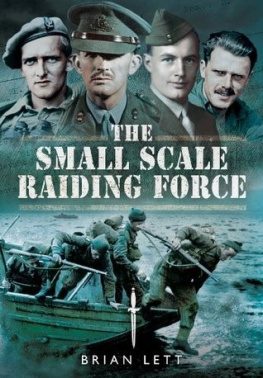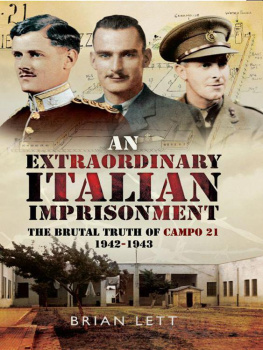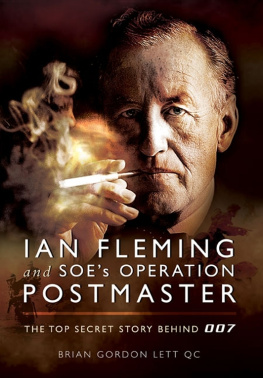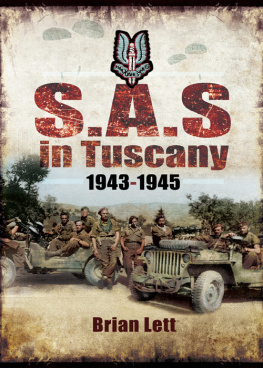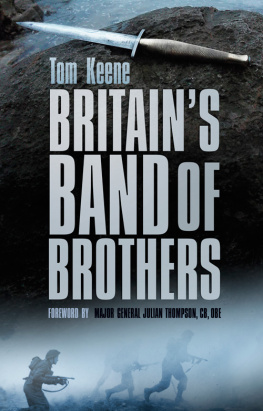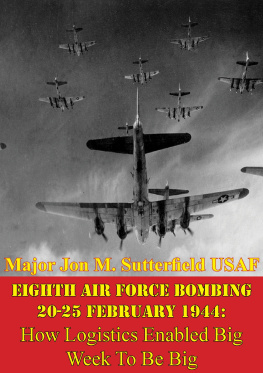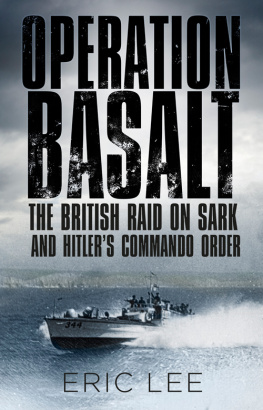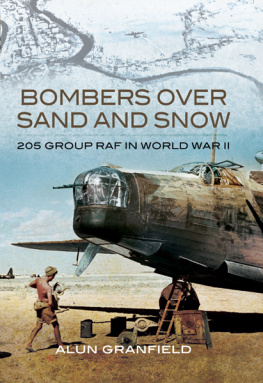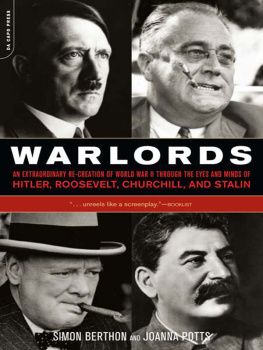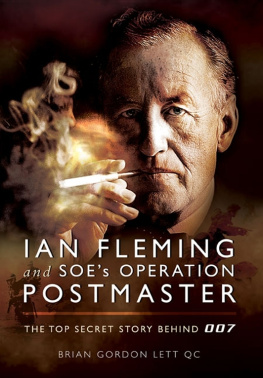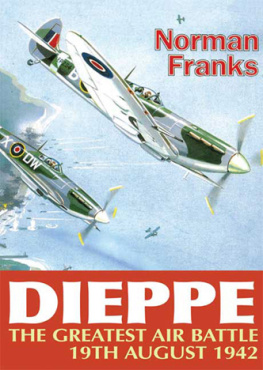First published in Great Britain in 2013 by
Pen & Sword Military
an imprint of
Pen & Sword Books Ltd
47 Church Street
Barnsley
South Yorkshire
S70 2AS
Copyright H.B.G. Lett 2013
HARDBACK ISBN: 978-1-78159-394-3
PDF ISBN: 978-1-47383-116-2
EPUB ISBN: 978-1-47383-000-4
PRC ISBN: 978-1-47383-058-5
The right of Brian Lett to be identified as author of this work has been
asserted by him in accordance with the Copyright, Designs and
Patents Act 1988.
A CIP catalogue record for this book is available from the British Library.
All rights reserved. No part of this book may be reproduced or transmitted in
any form or by any means, electronic or mechanical including photocopying,
recording or by any information storage and retrieval system, without
permission from the Publisher in writing.
Typeset in 11pt Ehrhardt by
Mac Style, Beverley, E. Yorkshire
Printed and bound in the UK by CPI Group (UK) Ltd, Croydon, CRO 4YY
Pen & Sword Books Ltd incorporates the Imprints of Pen & Sword Aviation,
Pen & Sword Family History, Pen & Sword Maritime, Pen & Sword Military,
Pen & Sword Discovery, Wharncliffe Local History, Wharncliffe True Crime,
Wharncliffe Transport, Pen & Sword Select, Pen & Sword Military Classics,
Leo Cooper, The Praetorian Press, Remember When, Seaforth Publishing
and Frontline Publishing.
For a complete list of Pen & Sword titles please contact
PEN & SWORD BOOKS LIMITED
47 Church Street, Barnsley, South Yorkshire, S70 2AS, England
E-mail:
Website: www.pen-and-sword.co.uk
www.brianlettauthor.com
Other books by the same author:
SAS in Tuscany
Ian Fleming and SOEs Operation Postmaster
For Valerie
Contents
List of Illustrations
Introduction
T his book is the second in a two-part study of Major Gus March-Phillipps DSO, MBE, and the extraordinary bands of seaborne commandos and secret agents that he led during the first half of World War Two. In Ian Fleming and SOEs Operation Postmaster, I described that operation and set out the facts that led me to an inescapable conclusion: that Ian Fleming had based his fictional secret agent James Bond on the characters of Gus March-Phillipps and three of his comrades, Geoffrey Appleyard, Graham Hayes and Anders Lassen. However, the James Bond connection was not the point of that book. The story of Operation Postmaster is a remarkable one, and in many ways, the links with Fleming and James Bond were an unwelcome intrusion. However, so much has been written about Ian Fleming and the possible inspirations behind his creations, Bond and M, that when I discovered the evidence, I felt it should be put on record. Of course, most of us enjoy a good Bond film or book without worrying about the history that lies behind it. For those who do want to know, this book and its predecessor tell the story.
James Bond was an agent of the Special Operations Executive (SOE), which was run by a man who really did use the code name M, Major General Sir Colin McVean Gubbins DSO, MC. Ian Fleming worked with SOE very closely in the early years of the war, and knew the characters involved well. Indeed, Gus March-Phillipps was Ian Flemings exact contemporary, and was everything that Fleming was not a successful commando secret agent and a genuine hero, and at the same time a successful novelist with three published novels already to his name. Had Gus March-Phillipps survived the war there is little doubt that he would have written the James Bond series.
My own father, Major Gordon Lett DSO, was a member of SOE, and remained in the intelligence community after the war. It always interested me that he had such a low opinion of Fleming, and was rather dismissive of the exploits of his James Bond. I know now that this was because Fleming was in fact writing of SOE, and deliberately came very close to giving away significant secrets. My father knew M (Sir Colin Gubbins) well, but whether he ever met Fleming I do not know.
Although Fleming was closely involved in Operation Postmaster, and met the personnel engaged on it, I have found no direct evidence to suggest that he had anything to do with the activities of the Small Scale Raiding Force. However, it was a quasi naval unit (a part of Ms secret navy), and there is no doubt that Fleming would have been aware of its activities in 1942 and 1943. Indeed, he was involved in the setting up of a not dissimilar unit to the SSRF within the Royal Navy 30 Assault Unit. Thus Ian Fleming plays no direct part in this book, although he would no doubt have followed the remarkable careers of March-Phillipps, Appleyard, Hayes and Lassen to their conclusions.
Accordingly, this book makes only minimal reference to Ian Fleming and his fictional agent, Bond. Indeed, when with the SSRF, March-Phillipps and his men were working as commandos rather than secret agents, albeit that they remained on the roll of Ms Secret Service and under his operational command. The reader is left to judge whether the continued true life exploits of March-Phillipps, Appleyard, Hayes and Lassen, after they had completed Operation Postmaster and parted company with Ian Fleming, also provided inspiration for Flemings eventual Bond character. The members of the Small Scale Raiding Force described in this book were all courageous men who command my deep respect. I only hope that I have done them justice.
Chapter 1
Return to England
T o any casual observer who might have been watching, the arrival of Gus March-Phillipps and Geoffrey Appleyard in Baker Street on a cold winters morning in February 1942 would have seemed unremarkable. They were two ordinary-looking men, one in his thirties with a moustache and receding hairline, the other in his mid-twenties and rather handsome, amongst the many thousands who thronged war-damaged London that winter. The premises that they entered, 64 Baker Street, was to the outside world the headquarters of the Inter Services Research Bureau (ISRB), which regularly received men from all branches of the military through its doors, some in uniform, some not. What an observer could not have known was that March-Phillipps and Appleyard were actually secret agents, reporting back to their boss at his Secret Service headquarters, after completing one of the wars most remarkable commando operations.
Their boss was Brigadier Colin McVean Gubbins DSO, MC, code name M the name that Commander Ian Fleming would later borrow for the controller of his fictional secret agent, James Bond. Fleming, who knew the workings of Ms Secret Service intimately at this stage, described 64 Baker Street in his books as a large grey building near Regents Park. March-Phillipps and Appleyard were two of the real licensed to kill secret agents upon whom the character of Bond was to be based.
The Inter Services Research Bureau was itself a code name. Ms Secret Service was the most secret of all the British wartime services. Officially, it did not exist, nor did its agents. Their activities were deniable. The real name of the ISRB was the Special Operations Executive (SOE), and M was its Operations and Training Director. Even after the Second World War had come to an end, and SOE had been officially disbanded, the fact that it had existed remained a secret, and not until the eventual collapse of the Soviet Union did the whole truth about its activities begin to be told.
Those who have read Ian Fleming and SOES Operation Postmaster, or others of the increasing number of books available on the history of SOE, will be familiar with the varied and extensive role that SOE played in the Second World War. However, for those who are new to the complexities of SOE, a summary of its history and activities is appropriate here. SOE was not bound by the Armys rules and red tape, it was a covert organization of irregulars, supported by a sophisticated gadgets and dirty tricks department. Since officially SOE did not exist, it operated on a strict need to know basis, both in its relations with the three regular Armed Services, and within its own ranks. Its operatives were, in the early years, often paid in cash, to avoid the necessity of banking entries and wage records. SOE had been born in July 1940, in the desperate days after the great British defeat at Dunkirk. A secret high-level meeting took place at the Foreign Office, which resulted in the setting up of a new and very secret Secret Service. Dr Hugh Dalton, the Minister for Economic Warfare, described the purpose of SOE in a lettter to Lord Halifax:
Next page
